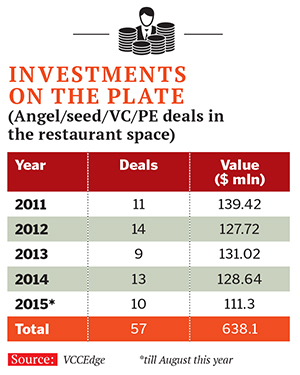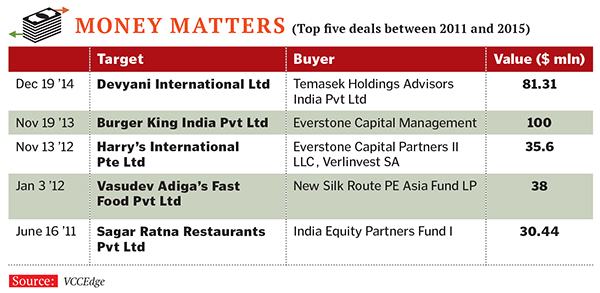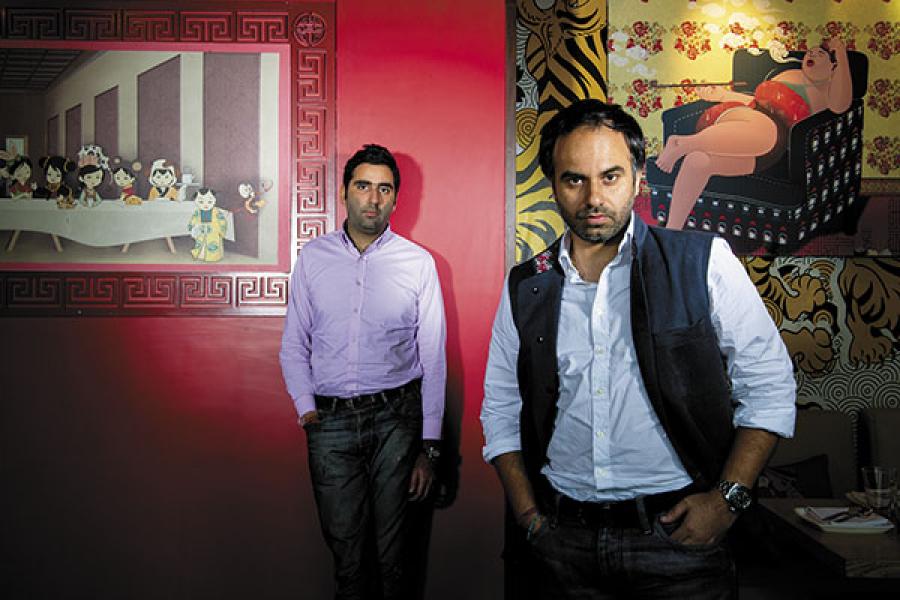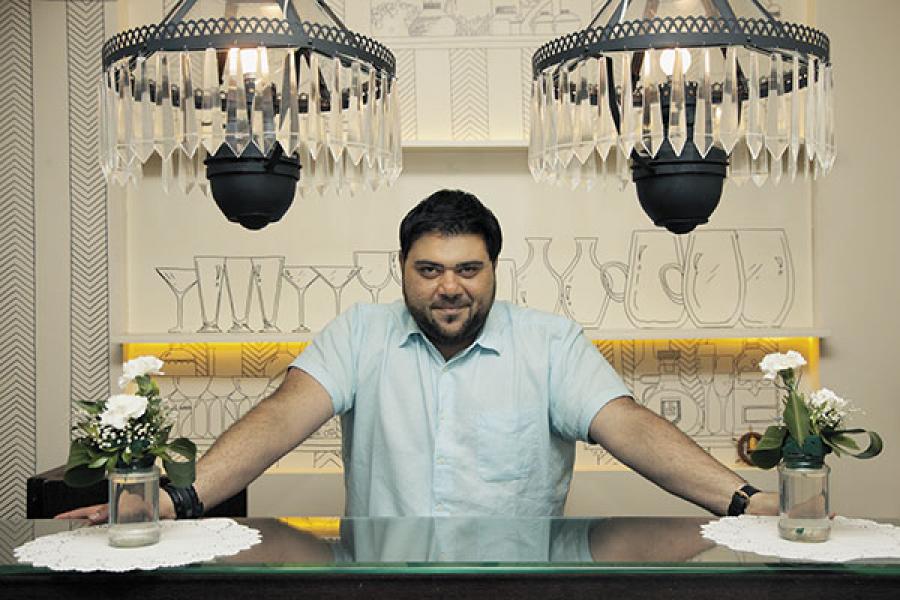
Investors show a growing appetite for food
In a hat-tip to the enduring appeal of the food service sector, Azure Hospitality, which runs the Mamagoto chain of restaurants, recently raised $10 million from Goldman Sachs. Clearly, despite the challenges of the industry, investors are putting money where their mouth is
When close friends Kabir Suri, 34, and Rahul Khanna, 32, decided to start a casual pan-Asian restaurant called Mamagoto in New Delhi’s upscale Khan Market in January 2010, they had a well-defined business strategy. “It was definitely meant to be a chain,” says Khanna. “When we were devising our menu, style of service, uniforms, etc, we asked ourselves: ‘Is this scalable?’ If the answer was no, we didn’t get into it.” The focus was on building a strong brand based on a template that could be easily replicated.
Five years on, their company, Azure Hospitality, runs nine Mamagoto restaurants in the country and 10 other outlets under their quick service restaurant (QSR) brands Rollmaal and Speedy Chow. And, this July, Azure Hospitality raised $10 million in growth capital from investment bank Goldman Sachs.
Now this isn’t the largest investment in the Indian food service industry. Not by a long shot. For instance, late last year, Singapore’s Temasek Holdings Advisors invested $81.31 million in Devyani International, which operates over 500 outlets of Pizza Hut, KFC, Costa Coffee and Vaango, among others, in India.
Big as these deals may be, they pale in comparison to the investments pouring into the food tech space. Earlier this month, Temasek, along with Vy Capital, invested $60 million into online restaurant aggregator, Zomato. Also, in April, Zomato had already raised $50 million in a round led by its existing investor Info Edge. In another development emblematic of the sector’s brisk growth, Rocket Internet-backed food delivery service Foodpanda raised $100 million from Goldman Sachs in May.
However, while the new-age food tech sector may be all the buzz, the core business of food remains an attractive avenue for investment. And the Azure deal is a hat-tip to the enduring appeal of the food service sector, which is expected to grow at a compound annual growth rate (CAGR) of 8 percent from Rs 272,680 crore in 2014 to Rs 423,140 crore in 2020, according to a QSR market report by management consulting firm Technopak Advisors. This growth is expected to be driven by a 15 percent CAGR in the restaurant chain segment.
As Mukul Singhal, principal, SAIF Partners, whose firm is an investor in the listed Speciality Restaurants Ltd, which owns and operates brands such as Mainland China, Oh! Calcutta and Cafe Mezzuna, puts it: “Food is a large spend bucket in itself. Restaurants belong to a very fragmented market, which is also highly unorganised, with no single large business. Therefore there is scope to create large companies.” But there are challenges, he adds. “The success rate is low so investors need to be disciplined.”
Unpretentious, young and quirky
Suri and Khanna had discussed the possibility of jointly opening a restaurant soon after they returned to India in 2008, having spent nine and 10 years abroad, respectively. But friendships can sour fast in business, says Khanna, who is a hospitality management graduate from Switzerland’s Ecole hôtelière de Lausanne and has also worked with the Mandarin Oriental and Jumeirah (the latter as team leader, food and beverages). “Both of us were quite hesitant about getting into business with each other. In theory, we wanted to do it, but we knew we had to be very careful.” So they took their time.
Shortly after returning, Khanna opened Below 8 in Gurgaon. “It was loosely based on a wine bar I used to love while I was working abroad,” he tells Forbes India. Below 8 closed last year after the lease expired and Khanna became busy with Mamagoto.
His partner Suri, too, had experience in the hospitality industry, having worked for three years, first in operations and later in business development, with international Japanese restaurants Zuma and Roka.
Around 2008, there was an explosion of cafes in India, bringing in the culture of casual dining. As it became evident to the two friends that India’s youth was driving growth in the food service sector, Khanna and Suri began to identify a niche. “Mamagoto was about finding a niche in the market and whether there was something fun we could do with it,” says Khanna.

And since they felt there were no ‘authentic’ pan-Asian cafés in the country, they decided to start one. “We wanted to make a place that was unpretentious, young and quirky,” says Khanna. A quick glance at any Mamagoto outlet is enough to validate this claim: From the bright, colourful artworks on the walls to the innovative lighting and staff uniforms. “The visual language of the brand, the quirkiness and the appeal of the price point were the three main things we kept in mind,” says Suri.
The ambience is dictated by the clientèle they expect. “It had to be a place where people could walk in wearing shorts, be relaxed and not be served food only during meal hours,” insists Khanna. The menu is as quirky as the interior, with innovative takes on traditional dishes like Burmese Khao Suey, which is served without any condiments and is called Chiang Mai Train Station Noodles. “We keep experimenting,” says Khanna, “our latest menu has hummus with wasabi in it.”
Wait a while
Khanna and Suri had all the right ingredients for a successful launch but, like other restaurateurs, they had to prepare for stiffer challenges ahead. “In this sector, sustaining consumer interest is the biggest challenge,” says Tarun Khanna, a partner with CX Advisors LLP, which has invested $35 million in the popular food chain Barbeque Nation. “There’s always a new restaurant or bar which is a hit for a few months and then it goes away.”
Azure Hospitality’s investors would agree. “When we approached our angel investors (Gautam Thapar, founder and chairman of the Avantha Group, and Mauritius-based Blue Sky Capital), we had gone with a mandate to open five restaurants,” says Rahul Khanna. However, the investors urged them to first open just one and gauge customer reaction. “Good PR can fill your restaurant for 2-3 months,” he says, “but it’s what happens next that matters.”
“You have to get your value proposition right,” says Thapar. “We did not want them to scale unless they got it right.” After about seven months, investor confidence strengthened, and the duo finally received the funds for four more restaurants.
The cautious approach stems from the perception that some restaurant companies were scaling up too fast or getting private equity (PE) money and signing impractical lease agreements. “In the past, the sector had gotten a bad name,” says Riyaaz Amlani of Impresario, which runs Smoke House Deli and Social, among several other bars and restaurants. He cites the same stories, including those of investors not being able to make a profit, that made them wary of putting money in the industry.
But this trend has been changing for a while. Approximately $128 million in investment went into the restaurant space in 2014, and investors have already poured in about $111 million in eight months this year, says VCCEdge.
In the last three months alone, about $72 million has been pumped into the sector. With a $30 million investment in July, India Value Fund Advisors acquired a controlling stake in deGustibus Hospitality, the parent company of Indigo restaurants. In the same month, a consortium of investors led by Samara Capital acquired the south and west India operations of the Pizza Hut franchise from the Dodsal Group for a reported sum of Rs 200 crore. Later, in August, it was reported that Carpedium Capital Partners had picked up a stake for an undisclosed amount in Gurgaon-based Thea Kitchen, which runs Biryani Blues, a QSR chain. A number of other investments are expected, including one in Impresario, claims Amlani.
Strong backbone
“Very often, what you don’t see in this business [back end] is what needs to be the strongest,” says Rahul Khanna. According to him, the problem with many horror stories in the restaurant business was that they were growing without strengthening their back end. “They had the best locations, good chefs, but bad purchase, recruitment networks and accountants.” He admits that “even 2-3 years ago, our own systems were not there yet”.
“As we grew, we got better people, and we spent time strengthening our back end,” he adds. It was only in 2012, when they were satisfied with the strength of their network, that Khanna and Suri started the process of opening 14 restaurants in a year, including launching their two QSR brands.
It is at this stage that brand identity can begin to flounder. “You have to keep engaging with the customer to make sure you remain relevant,” says Suri. Thapar believes understanding what the customer appreciates in your brand and continuing to provide them with that is essential. “Competition should not make you change your value proposition,” says Thapar. Once the continuous focus in value drivers is ingrained, it should penetrate the entire organisation, he adds.
Scaling up
While there are challenges aplenty in any business, scale, above all, seems to be a point of conflict between restaurateurs and prospective investors: “You may create a brand, but is it strong enough for a financial investor?” asks Tarun Khanna. An entrepreneur is going to have a different perspective on scale than an investor, he says.
Very few restaurants in India have been able to scale their operations successfully, say experts.
“A restaurant is a holistic product. When scaling up, a restaurateur has to ensure the consistency of food and the service, and maintain the same standard for 365 days in a year. This to me is the biggest challenge and a reason why the restaurant mortality rate in the country is very high,” says Anjan Chatterjee, the founder of Speciality Restaurants.
Chatterjee, who forayed into the restaurant business in 1992, says nearly 50 percent of the restaurants that start shop across the country’s top metros die in the first or second year of operation due to consistency related issues.

Casual-dining restaurant chain Barbeque Nation, which runs 53 restaurants in 23 cities, is one of the few exceptions.
However, the biggest success story in the Indian restaurant space isn’t even an Indian brand. Domino’s Pizza, whose India operations are run by Jubilant Food Works, continues to be the gold standard for both indigenous and foreign brands entering India. With 887 restaurants (as of May, according to the company’s website; the Technopak report estimates the number to be about 927), it is by far India’s largest restaurant brand.
“When you open a one-off restaurant, you can be adventurous and try different things with the menu and design,” says Suri. However, with Mamagoto, considering that they were going to build a chain, the pair had devised a limited menu, since it had to be replicated quickly.
The single-minded focus on building a chain from the beginning may well bear fruit for Azure Hospitality at this stage. “From day one, our graphic brand identity was quite loud. In a crowded mall, you can easily spot Mamagoto,” says Rahul Khanna. Keeping scalability in mind helped them avoid the incorporation of certain items in their menu. “For instance, we did not include sushi,” since raw fish would require a cold chain network, he points out.
Speed is another concern. Suri says it takes his company three months to set up a restaurant. This is also why Azure Hospitality’s QSR brands Rollmaal and Speedy Chow are important. Although the margins are low and it takes a long time to break even, Suri believes the low capital expenditure and the possible synergies with technology-based food platforms make QSR a very exciting space. According to the Technopak report, within the sphere of chain restaurants, QSR is already the single largest sub-category. The total size of chain restaurants in India for 2014 was estimated to be Rs 15,445 crore, of which QSR constitutes Rs 6,875 crore.
There’s another worry, one that most brick-and-mortar retail businesses face: The ideal location. There are only so many prime spots in a city that can offer rentals that can enable a profitable business. For Suri, it’s about timing and being patient. “We have an understanding with Goldman Sachs that we’re not looking to go Kamikaze with our openings,” says Suri. The relationship between the promoters and investors at this stage is of utmost importance. “They need to be able to understand each other’s mindsets, and be patient and respectful of each other’s functioning and expectations,” says Suri. Thapar, too, believes that in an investment of the size that Goldman Sachs has made, trust and chemistry are important. “Hospitality is an intense people’s business,” says Thapar, “and in India, personal relationships matter.”
Some other challenges are more specific to the restaurant business. For instance, Suri says the lack of availability of certain ingredients for Mamagato’s offerings at affordable prices is a cause for concern. In addition to this, every restaurant chain is looking to get the best talent, from chefs to waiters to even the delivery riders. In fact, says Suri, “with the ecommerce boom, we’re constantly fighting to get delivery riders”.
The emergence of food tech companies has brought about changes that go beyond the delivery rider crunch. “The industry is seeing disruptions from the likes of mobile-based food apps and online food portals. It is important for us to be nimble-footed so that we are ready for the next big leap,” Chatterjee says. But while online platforms and restaurants vary in approach, synergies do exist. For instance, Rahul Khanna believes food tech platforms can provide restaurants valuable visibility.
Positive outlook
There is little to deny that “the last four to five quarters have been tough for India’s listed restaurant companies,” says Abneesh Roy, associate director at Edelweiss Capital.
Roy cites slow urban consumption growth as one of the reasons for this slump. However, he insists that the food service sector continues to be attractive in the long term. After all, the organised sector, which is relatively small, is growing at a rapid pace, according to the Technopak report. Of the total size of the food service industry, estimated at Rs 272,680 crore, the organised sector, which consists of licenced standalone restaurants and chains, makes up only about 29 percent (Rs 78,980 crore). The restaurant chain segment is about a third of the organised sector, the report states. However, with a projected growth rate of 15 percent, it is by far the fastest growing sub-category. “Restaurant businesses are cash flow businesses,” says Thapar. “And all the demographics point towards changing habits.”
Azure Hospitality, which did not share financial details, has been a beneficiary of the changing consumer habits. “The only number I can share with you is that our topline has been growing at 55 percent,” says Khanna. Co-founder Suri says the average revenue per cover (the amount a customer spends on average in a restaurant) for Mamagoto is about Rs 750. “Our table turnovers are the highest in the market in terms of square footage,” claims Suri. The table turnover number, which is the ratio of customers served to the number of restaurant seats, is over two-and-a-half times, says Suri.
And, with the $10 million from Goldman Sachs, it is setting out on a growth trajectory, which will include the opening of 4-5 Mamagotos and 6-8 Rollmaals and Speedy Chows a year. The variables that may go against it are numerous. However, as Suri puts it, “Ultimately, it is the food that sells, no matter what you do.” That, you can’t argue with.
(This story appears in the 02 October, 2015 issue of Forbes India. To visit our Archives, click here.)

















